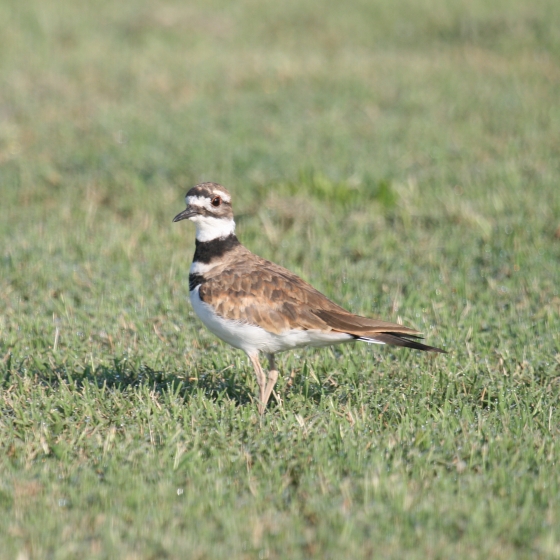Killdeer

Introduction
A larger version of the Ringed Plover, but with a double breast band, the Killdeer is an almost annual visitor from North America.
To stop cows and horses trampling its nest, the Killdeer fluffs itself up, displays its tail over its head, and runs at the beast in an attempt to make it change its path.

Key Stats
Status and Trends
Conservation Status
Population Size
Population Change
Population trends of this scarce species are not routinely monitored.
Distribution
This species is a rare vagrant and was recorded during Bird Atlas 2007–11 as shown on the map.
Occupied 10-km squares in UK
or view it on Bird Atlas Mapstore.
or view it on Bird Atlas Mapstore.
Distribution Change
This vagrant is too rarely reported to map distribution change.
Change in occupied 10-km squares in the UK
Seasonality
This species has been too rarely reported to BirdTrack during 2011–22 to properly assess seasonality.
Movement
Britain & Ireland movement
Biology
Survival and Longevity
Survival is shown as the proportion of birds surviving from one year to the next and is derived from bird ringing data. It can also be used to estimate how long birds typically live.
Classification, names and codes
Classification and Codes
- Order: Charadriiformes
- Family: Charadriidae
- Scientific name: Charadrius vociferus
- Authority: Linnaeus, 1758
- BTO 2-letter code: KL
- BTO 5-letter code: KILLD
- Euring code number: 4740
Alternate species names
- Catalan: corriol cua-roig
- Czech: kulík rezavoocasý
- Danish: Kildire
- Dutch: Killdeerplevier
- Estonian: kilatüll
- Finnish: amerikantylli
- French: Pluvier kildir
- German: Keilschwanz-Regenpfeifer
- Hungarian: ékfarkú lile
- Icelandic: Skræklóa
- Irish: Feadóg Ghlórach
- Italian: Corriere vocifero
- Latvian: skalais tartinš
- Lithuanian: balsingasis kirlikas
- Norwegian: Tobeltelo
- Polish: sieweczka krzykliwa
- Portuguese: borrelho-de-coleira-dupla
- Slovak: kulík kriklavý
- Slovenian: kildir
- Spanish: Chorlitejo culirrojo
- Swedish: skrikstrandpipare
- Welsh: Cwtiad Torchog Mawr

